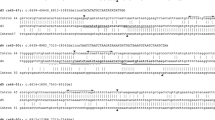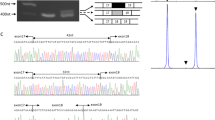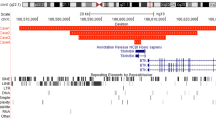Abstract
Duchenne muscular dystrophy (DMD) is an X-linked recessive disorder which affects approximately 1 in 3,300 males, making it the most common of the neuromuscular dystrophies (see ref. 1 for review). The biochemical basis of the disease is unknown and as yet no effective treatment is available. A small number of females are also affected with the disease, and these have been found to carry X;autosome translocations2,3 involving variable autosomal sites but always with a breakpoint within band Xp21 of the X chromosome (implicated by other kinds of genetic evidence as the site of the DMD lesion4–6. In these female patients the normal X chromosome is preferentially inactivated, which it is assumed silences their one normal DMD gene, leading to expression of the disease. In one such affected female the autosomal breakpoint lies in the middle of the short arm of chromosome 21 (ref. 2), within a cluster of ribosomal RNA genes7. Here we have used rRNA sequences as probes to clone the region spanning the translocation breakpoint. A sequence derived from the X-chromosomal portion of the clone detects a restriction fragment length polymorphism (RFLP) which is closely linked to the DMD gene and uncovers chromosomal deletions in some male DMD patients.
This is a preview of subscription content, access via your institution
Access options
Subscribe to this journal
Receive 51 print issues and online access
$199.00 per year
only $3.90 per issue
Buy this article
- Purchase on Springer Link
- Instant access to full article PDF
Prices may be subject to local taxes which are calculated during checkout
Similar content being viewed by others
References
Moser, H. Hum. Genet. 66, 17–40 (1984).
Verellen-Dumoulin, C. et al. Hum. Genet. 67, 115–119 (1984).
Elejalde, B. R. & Elejalde, M. M. Cytogenetics of the X chromosome 2nd edn (ed. Sandberg, A. A.) 225–244 (Liss, New York, 1983).
de Martinville, B. et al. Am. J. hum. genet. 37, 235–249 (1985).
Franke, U. et al. Am. J. hum. Genet. 37, 250–267 (1985).
Davies, K. E. J. med. genet. 22, 243–249 (1985).
Worten, R. G., Duff, C., Sylvester, J. E., Schmickel, R. D. & Willard, H. F. Science 224, 1447–1448 (1984).
Worten, R. G. et al. UCLA Symp. molec. Biol Muscle Development (in the press).
Erickson, J. M., Rushford, C. L., Dorney, D. J., Wilson, G. H. & Schmickel, R. D. Gene 16, 1–9 (1981).
Gonzalez, I. L. et al. Proc. natn. Acad. sci. U.S.A. (in the press).
Hassouna, N., Michot, B. & Bachellerie, J.-P. Nucleic Acids Res. 12, 3563–3583 (1984).
Loenen, W. A. M. & Blattner, F. R. Gene 26, 171–179 (1983).
Wyman, A. R., Wolfe, L. B. & Botstein, D. Proc. natn. Acad. Sci. U.S.A. 82, 2880–2884 (1984).
Conneally, P. M. & Rivas, M. L. Adv. hum. Genet. 10, 209–266 (1980).
Kunkel, L. M., Monaco, A. P., Middlesworth, W., Ochs, H. D. & Latt, S. A. Proc. natn. Acad. Sci. U.S.A. 82, 4778–4782 (1985).
Monaco, A. P. et al. Nature 316, 842–845 (1985).
Wellaur, P. K. & Dawid, I. B. J. molec. Biol. 128, 289–303 (1979).
Willard, H. F., Smith, K. D. & Sutherland, J. Nucleic Acids Res. 11, 2017–2033 (1983).
Maniatis, T., Fritsch, E. F. & Sambrook, J., Molecular Cloning: A Laboratory Manual (Cold Spring Harbor Laboratory, New York, 1982).
Author information
Authors and Affiliations
Rights and permissions
About this article
Cite this article
Ray, P., Belfall, B., Duff, C. et al. Cloning of the breakpoint of an X;21 translocation associated with Duchenne muscular dystrophy. Nature 318, 672–675 (1985). https://doi.org/10.1038/318672a0
Received:
Accepted:
Issue Date:
DOI: https://doi.org/10.1038/318672a0
This article is cited by
-
Patterns of left ventricular remodeling in patients with Duchenne Muscular Dystrophy: a cardiac MRI study of ventricular geometry, global function, and strain
The International Journal of Cardiovascular Imaging (2012)
-
Presence of mechanical dyssynchrony in duchenne muscular dystrophy
Journal of Cardiovascular Magnetic Resonance (2011)
-
Effects of steroids and angiotensin converting enzyme inhibition on circumferential strain in boys with Duchenne muscular dystrophy: a cross-sectional and longitudinal study utilizing cardiovascular magnetic resonance
Journal of Cardiovascular Magnetic Resonance (2011)
-
Mutations in GRIN2A and GRIN2B encoding regulatory subunits of NMDA receptors cause variable neurodevelopmental phenotypes
Nature Genetics (2010)
-
MODY-like diabetes associated with an apparently balanced translocation: possible involvement of MPP7 gene and cell polarity in the pathogenesis of diabetes
Molecular Cytogenetics (2009)
Comments
By submitting a comment you agree to abide by our Terms and Community Guidelines. If you find something abusive or that does not comply with our terms or guidelines please flag it as inappropriate.



